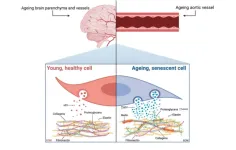(Press-News.org) (03/29/2023) — Resistance to Paxlovid is already evident among viral SARS-CoV-2 variants currently circulating globally, indicating that this stand-alone drug known as a protease inhibitor could soon become less effective in treating COVID-19 infections.
This conclusion was presented in a study published today online in the peer-reviewed journal Science Advances.
This study — conducted by the Midwest Antiviral Drug Discovery (AViDD) Center — shows that drug-resistant variants have appeared multiple times independently in different parts of the world, with regional clusters providing evidence for person-to-person transmission. In addition to showing resistance to the protease inhibitor nirmatrelvir, the active component of Paxlovid, the study found that a different set of mutations currently in circulation can transfer resistance to ensitrelvir (Xocova), a protease inhibitor now approved in Japan. This new research shows that simple single amino acid changes in SARS-CoV-2 main protease could severely undermine efficacy of these antiviral drugs.
According to Reuben Harris, PhD, co-director of the Midwest AViDD Center, “although our study demonstrates the existence of natural circulating SARS-CoV-2 variants with resistance to two different drugs, the good news is that their resistance profiles are distinct. This means that if one of these drugs fails due to emergence of resistance in viral variants, the other drug may still work.”
Further research is likely to develop additional next-generation protease inhibitors with different resistance profiles, as well as drugs that target different viral processes such as replication or cell entry. A multi-drug approach—like existing therapies for HIV and Hepatitis C virus — could further help to protect against resistance and cure SARS-CoV-2-infected individuals.
To lower the risk of resistance, the researchers say protease inhibitors must be carefully designed to avoid simple resistance mutations.
“Despite Paxlovid’s proven success in blunting COVID-19 symptoms, the long-term consequences of its widespread use in speeding up resistance are unknown,” said S. Arad Moghadasi, co-author of the study and a University of Minnesota Medical School graduate student. “Drugs with the highest barriers to resistance are likely to prove more effective and have longer-term durability.”
“We are optimistic that ongoing studies will develop additional compounds to avoid cross-resistance and help combat the current COVID-19 pandemic and future coronavirus outbreaks,” said Harris, a professor and chair of biochemistry and structural biology at the University of Texas Health Science Center at San Antonio, a Midwest AViDD Center partner, and an investigator of the Howard Hughes Medical Institute.
This research was supported by the National Institute of Allergy and Infectious Diseases (U19-AI171954).
###
About the Midwest AViDD Center
The Midwest AViDD Center is developing the next generation of antiviral drugs for pandemic-level viruses, including SARS-CoV-2, Ebola, Lassa, and Zika. Headquartered at the University of Minnesota and including 18 other institutions nationwide, the Midwest AViDD Center is part of a network of nine national centers established by the National Institute of Allergy and Infectious Diseases (NIAID), part of the National Institutes of Health.
About the University of Minnesota Medical School
The University of Minnesota Medical School is at the forefront of learning and discovery, transforming medical care and educating the next generation of physicians. Our graduates and faculty produce high-impact biomedical research and advance the practice of medicine. We acknowledge that the U of M Medical School, both the Twin Cities campus and Duluth campus, is located on traditional, ancestral and contemporary lands of the Dakota and the Ojibwe, and scores of other Indigenous people, and we affirm our commitment to tribal communities and their sovereignty as we seek to improve and strengthen our relations with tribal nations. For more information about the U of M Medical School, please visit med.umn.edu.
For media requests, please contact:
Kali Kotoski, Communications Director for the Midwest AViDD Center
651-338-0619, Kotos001@umn.edu
END
Research Brief: Study finds evidence of resistance to COVID-19 drugs
2023-03-29
ELSE PRESS RELEASES FROM THIS DATE:
Senescence and extracellular vesicles: novel partners in vascular amyloidosis
2023-03-29
“[...] there has been limited research to date on the effect of cellular ‘ageing’, termed senescence, on amyloidosis.”
BUFFALO, NY- March 29, 2023 – A new editorial paper was published in Aging (listed by MEDLINE/PubMed as "Aging (Albany NY)" and "Aging-US" by Web of Science) Volume 15, Issue 5, entitled, “Senescence and extracellular vesicles: novel partners in vascular amyloidosis.”
In their editorial, researchers Meredith Whitehead, Marco Antonazzi and Catherine M. Shanahan from King’s College London discussed amyloidosis—a ...
Excess death gap widens between US and Europe
2023-03-29
A new analysis shows that, compared to similarly high-income European countries, the US continues to have substantially higher death rates at all but the oldest ages, resulting in more “excess deaths,” and this gap widened during the Covid-19 pandemic. Patrick Heuveline, of the University of California, Los Angeles (UCLA), presents these findings in the open-access journal PLOS ONE on March 29, 2023.
Calculating excess death rates can be useful for comparing mortality between different countries or sub-populations, as well as before and after the onset of a health crisis. Prior research has documented a substantial widening of ...
Ancient giant amphibians swam like crocodiles 250 million years ago
2023-03-29
Ancient 2m-long amphibians swam like crocodiles long before true crocodiles existed, according to a study published March 29, 2023 in the open-access journal PLOS ONE by David P. Groenewald of the University of the Witwatersrand, South Africa and colleagues.
During the Late Permian Period, just over 250 million years ago, South Africa was home to rhinesuchid temnospondyls, large predatory amphibians with bodies similar to crocodiles or big salamanders. These extinct animals are known mainly from skeletal remains, but in this study, researchers ...
In the very old, higher BMI is associated with more health complaints, and in overweight men, with mental health complaints too
2023-03-29
Article URL: https://journals.plos.org/plosone/article?id=10.1371/journal.pone.0283089
Article Title: The impact of BMI on psychological health in oldest old individuals–Are there differences between women and men?
Author Countries: Germany
Funding: This study was funded by the @ktivPLUS study (German Federal Ministry of Education and Research, grant number 01GY2108) awarded to M. Löbner. Publication was funded by the Open Access Publishing Fund of Leipzig University, which is supported by the German Research ...
Drones could be used reliably to map how and why pedestrians use city streets, according to a pilot study in Santiago de Chile
2023-03-29
Article URL: https://journals.plos.org/plosone/article?id=10.1371/journal.pone.0282024
Article Title: Pedestrian street behavior mapping using unmanned aerial vehicles. A case study in Santiago de Chile
Author Countries: Spain
Funding: OM has received funding from the Spanish Ministry of Science and Innovation of the Government of Spain (RyC RYC2020-029441-I). This research was also funded by the Ministry of Science and Innovation of the Government of Spain [grant number PID2019-104344RB-I00]. END ...
We are not yet approaching any maximum human lifespan, according to an examination of human mortality over time and across 19 countries
2023-03-29
###
Article URL: https://journals.plos.org/plosone/article?id=10.1371/journal.pone.0281752
Article Title: Mortality postponement and compression at older ages in human cohorts
Author Countries: USA
Funding: The authors received no specific funding for this work. END ...
Stereotypes about senior employees lead to premature retirements
2023-03-29
Unproductive, inflexible, and less motivated... these are some of the most common stereotypes about senior employees. Even though the stereotypes are usually unfounded, they nevertheless influence how senior employees perceive themselves and their status in the workplace. And they thus become a key factor in many senior employees’ retirement decisions, conclude University of Copenhagen researchers in a new study published in PLOS ONE.
“In our study, we refer to the uncertainty that senior employees feel about their status as ‘the worn-out syndrome’, which ...
Earth prefers to serve life in XXS and XXL sizes: UBC research
2023-03-29
Life comes in all shapes in sizes, but some sizes are more popular than others, new research from the University of British Columbia has found.
In the first study of its kind published today in PLOS ONE, Dr. Eden Tekwa, who conducted the study as a postdoctoral fellow at UBC’s department of zoology, surveyed the body sizes of all Earth’s living organisms, and uncovered an unexpected pattern. Contrary to what current theories can explain, our planet’s biomass—the material that makes up all living organisms—is ...
Nature favors all creatures great and small over medium size
2023-03-29
Life may come in all shapes and sizes, but in nature the most extreme size ranges predominate, according to Rutgers researchers.
A survey of body sizes of Earth organisms, published Wednesday, March 29, in the science journal PLoS ONE, shows that the planet’s biomass – the material that makes up all living organisms – is concentrated in organisms at either end of the size spectrum.
“This conclusion – that life on earth comes packaged predominantly in the largest and smallest sizes – was a discovery that surprised us,” said Malin Pinsky, an associate professor ...
Sox9 protein enables molecular time travel that can lead to colorectal cancer
2023-03-29
Study Title: Aberrant cell state plasticity mediated by developmental reprogramming precedes colorectal cancer initiation
Publication: Science Advances: March 29, 2023, 2:00pm ET 10.1126/sciadv.adf0927
Dana-Farber Cancer Institute author: Pratyusha Bala, PhD, Jonathan P. Rennhack, PhD, Daulet Aitymbayev, MS, Matthew B. Yurgelun, MD, William C. Hahn, MD, PhD, Nilay S. Sethi, MD, PhD
Summary:
Normally the lining of the colon forms a series of steep hills and valleys. At the surface, where the hills peak, are functional colon cells that do the organ’s work of absorption and secretion. Deep in the valleys are stem cells that constantly ...






